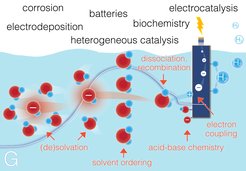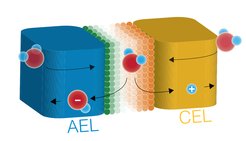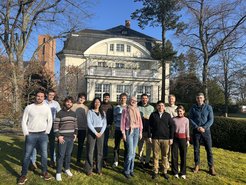
Interfacial Ionics
Interfacial ionic processes are everywhere. Consider water dissociation (WD), H2O → H+ + OH-, which is required for every proton-coupled reaction in bio- and electrochemistry at alkaline to neutral pH (i.e. where the H+ comes from H2O). Despite its importance, WD is poorly understood and limits the efficiency of key technologies - in particular of water electrolysis generating green hydrogen and bipolar membranes producing acid and base solutions from green electricity.

Another example is ionic (de)solvation occurring during Li+ intercalation in Li-ion batteries. The (de)solvation is thought to be one reason why these batteries cannot be (dis)charged faster and why performance degrades at colder temperatures. Grotthuss transport, hydrogen spillover, dehydrogenation in organic chemistry, proton gradients and action potentials in biochemistry - interfacial ionics are ubiquitous, but our understanding has remained very limited.

In our laboratory, we study interfacial ionics at technologically-relevant, bipolar membrane and operational (electro)catalyst interfaces. We want to understand how molecules are dissociated and formed and ions are (de)solvated. What is the role of local electrostatics and local acid-base chemistry in tuning interfacial ionic processes? What are the differences between driving reactions ionically vs. electrically, and can this tell us something about the similarities and differences between electro- and thermal catalysis?
To that end, we employ existing, state-of-the-art electrochemistry and (electro)catalyst characterization, while also developing new operando methods to track ionic processes in time and space at a plethora of heterogeneous interfaces.

Applying
Dr. Sebastian Oener strongly encourages applications from women and people of all backgrounds.
- Check the FHI career homepage for specific open position: https://www.fhi.mpg.de/open-positions.
- We always consider outstanding candidates. Please send a CV and cover letter describing succinctly how your skill set and interests specifically address our research program to oener@fhi-berlin.mpg.de. Due to the volume of applications received, we cannot respond to each one.
Group Leader
- 4111
PhD Students
- 4239
- 4239
- 4214
- 4431
Postdocs
- 4215
- 4631
- 4185
- 4222
- 4145
- 4185
- 4418
Guests
Recent Publications
Articles, peer-reviewed
Articles, non peer-reviewed


